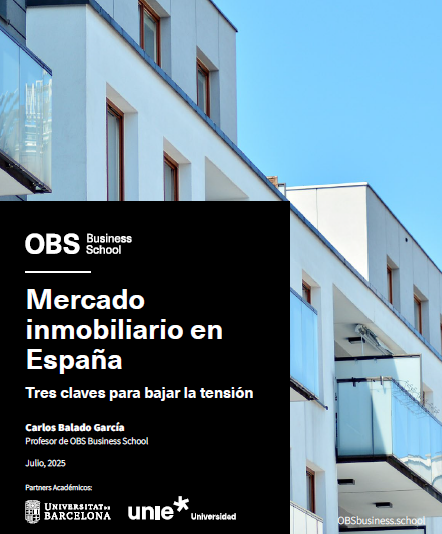
OBS Report: Real Estate Market in Spain 2025
Proposals to Stimulate Housing Access in Spain

- Amend the Land Law to ensure that housing development timelines are not as long as 20 years.
- Reduce the bureaucratic burden that affects housing production.
- Reinstate agreements with financial institutions to increase mortgage financing for young people and families without sufficient savings, through public guarantees.
- Streamline the procedures for the planning, management, and execution phases of projects to reduce timelines from 10 to 4 years.
- Comply with legal deadlines and issue reports in a timely manner. If not, consider them approved through positive administrative silence.
- Simultaneously process the Sectorization Plan (which designates land as developable) and the Partial Plan (which defines its uses).
- Revise housing taxation to make it more efficient by eliminating redundancies and avoiding inflationary effects on final prices.
- Implement inflation adjustment in the taxation of capital gains in Spain to improve fairness in the tax system, ensuring only real gains are taxed.
August 2025. OBS Business School, an institution that is part of the Planeta Formación y Universidades higher education network, publishes the report Real Estate Market in Spain 2025, led by Professor Carlos Balado. The report analyzes the evolution of the real estate market by autonomous communities and provinces during the first quarter of the year. Looking ahead to 2030, the population is expected to reach 52 million inhabitants, which will require between 1.6 and 2.3 million new homes over the next five years. In this context, the public administration acts more as a generator of risks than as an effective regulator.
Current Situation

The first quarter of 2025 set a new record in the Spanish real estate market, with over 181,000 property transactions—the highest level since 2007. This growth, driven by demand for both new and second-hand housing, could push the annual total beyond 732,000 transactions, according to forecasts.
Prices have also reached historic highs, with an average of €2,226/m², representing an 8.1% increase compared to the previous year. Madrid, the Balearic Islands, and the Basque Country top the ranking of the most expensive regions, while cities like San Sebastián, Madrid, and Barcelona lead the national list.
Despite the surge in sales, only 65.5% of transactions are financed through mortgages, although fixed-rate loans continue to rise, especially in Galicia, Asturias, and Catalonia.
However, affordability remains a challenge: in 19 provincial capitals, purchasing a home exceeds the recommended 35% of household income. Málaga tops the list with a concerning 59%, followed by Cádiz, San Sebastián, Madrid, and Barcelona. Only Zaragoza remains within reasonable affordability levels.
Is There a Shortage of Developable Land?
Although available land is scarce in Spain’s major cities, the country has around 255 million square meters of buildable land, which could allow for the construction of at least 1.8 million homes over the next 30 years. This figure reflects significant potential to meet housing demand, but tapping into it comes with challenges.
One of the main obstacles is the rising cost of land, which increased by an average of 7.9% in the second quarter of the year, reaching one of the highest levels in the past decade. In provinces such as Teruel, Soria, and Burgos, the price per square meter has more than doubled in just one year. However, in regions like Gipuzkoa and León, prices have dropped significantly—by 49% and 38%, respectively—a trend also seen in cities like Pamplona and Badajoz.
On the other hand, legal uncertainty and excessive bureaucracy further complicate the development of these projects, which already tend to take 10 to 15 years, and in some cases up to 20 years. The process of obtaining permits can take up to two years, and developers must navigate three levels of administration: municipal, regional, and national.
"The key lies in simplifying urban planning management through a unified process among administrations. Only then can we avoid the bottlenecks that currently delay housing development unnecessarily." - Professor Carlos Balado
Punitive Taxation

Taxes in Spain can increase the final price of a home by up to 45%. Moreover, this complex and burdensome tax structure affects all stakeholders—builders, developers, buyers, sellers, landlords, and tenants—making recent political party proposals seem insufficient and fragmented. High taxation, combined with excessive regulation and limited public investment in the sector, is worsening the current state of the real estate market.
From the moment a developer purchases land to the final acquisition by the buyer, up to 16 different types of taxes may be applied—sometimes repeatedly—depending on the transaction. This is because housing is a major source of revenue for the public administration. This year, the Spanish government expects to collect €52 billion in real estate-related taxes, representing approximately 3.5% of GDP. In contrast, public spending on housing policies barely reaches 0.5% of GDP, highlighting the low priority given to housing within the national budget.
Compared to other countries, Spain applies the third-highest maximum rate in Europe for transaction taxes, at 11%, surpassed only by Belgium (12.5%) and the United Kingdom (12%). It also ranks among the countries with the highest capital gains taxation, similar to Sweden and only behind economies like Denmark (42%), Norway (37.8%), and the Netherlands (36%). This heavy tax burden discourages buying and selling, reduces available supply, and creates inefficiencies that can ultimately lead to higher prices for buyers.
Content written by:
Carmen García-Trevijano
OBS Business School's Press Office



